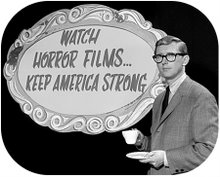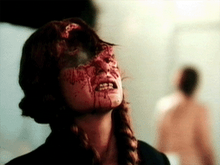Demons 2 gets most of the Demons filmmaking gang back together, including director Lamberto Bava, screenwriters Bava, Dario Argento, Dardano Sacchetti, and Franco Ferrini, producer Argento, cinematographer Gianlorenzo Battaglia, editors Franco Fraticelli and Piero Bozza, and production designer/art director Davide Bassan, with mostly excellent results, though there is a slight diminishing return due to familiarity replacing novelty, we get even less character development, and the setting (a high-rise apartment building) is not explored in as much detail as I would've preferred. Still, this is a freaky, kinetic, neon-drenched good time.
Two Demons leads even make repeat appearances, despite their characters getting murdered by, and then transformed into, demons in the first film. (They were then killed a second time in demonic form.) In the first film, Lino Salemme played the all-nonsense Ripper, member of a coke-snorting gang of punks who break into the movie theater mid-demonic onslaught. In Demons 2, he plays a no-nonsense security guard for the apartment building, billed only as "Security Guard" despite a decent amount of screen time. Most memorably, Bobby Rhodes is back. He was the no-nonsense pimp Tony in Demons, and this time he plays Hank, a just-a-tiny-bit-of-nonsense-but-mostly-no-nonsense personal trainer in the building's gym. He spends the first half of the film putting leotard-clad babes and oiled-up shorts-wearing hunks through their workout paces and the second half leading his fitness army into heated demon-fighting battle in the parking garage. In both films, if demonic shit goes down, Bobby Rhodes is the guy you want telling you what to do. Demons are probably going to kick your ass anyway, but at least you have a chance.
I already wrote about how much I love Demons and its movie theater setting, but Demons 2 has another great location in its big-city high-rise apartment building. I like these early scenes where we briefly get to know different apartment dwellers and employees and the layout of the building, and I wish we'd had a bit more of that before the demon chaos begins. As much as I love demon chaos, I think a few more party scenes and characters living their lives in the other apartments would have contributed to the atmosphere and made the demon chaos rip even harder.
Keeping the action in Germany but swapping Berlin for Hamburg (with additional studio shooting in Rome), Demons 2 takes place on a hopping Friday night in the high-rise. Teenager or early twentysomething (it's a little vague) Sally Day (Coralina Cataldi-Tassoni) is having a fancy-dress birthday party at her apartment (her parents skedaddle for an Oktoberfest-ish celebration a block away) and her fellow twentysomething teens keep arriving, to the chagrin of security guard Salemme, who has no patience for their elevator shenanigans (a couple of jokers keep pushing different buttons). We also get to know elevator-phobic sex worker Mary (Virginia Bryant), arriving at the same time as the teens to meet a client, a college-student couple, Hannah (Nancy Brilli) and George (David Edwin Knight), expecting their first baby (and whose apartment is a riot of neon), a family sitting down to dinner whose young daughter Ingrid is played by Asia Argento, and a single woman with a big fluffy dog. I can't forget the young boy, Tommy (Marco Vivio), neglectfully left alone by his parents, who has this incredible phone call, heard only from his end: "No, my mom is not home. ... No, my dad's not home, either. .... I'm here all alone. Goodbye!" I don't think the night would have ended well for the young lad even without the demons.
Even though it's her birthday, the cake has arrived, the Goth and alt-rock jams are blasting (Demons 2 swaps the first film's heavy metal and synth-pop for The Smiths, Art of Noise, Peter Murphy, Gene Loves Jezebel, Fields of the Nephilim, Dead Can Dance, Love and Rockets, and The Cult), she's young and pretty, and her friends are all here, Sally is losing it. She's a very high-strung person who changes moods on a dime, and she flips out about how much she hates her dresses before being cajoled by a friend to leave her bedroom and get to partying. While briefly forgetting her cares and dancing to The Smiths' "Panic," the phone rings. She ignores it, so another partygoer answers. He tells the caller to come on over to the party. Sally asks him who called, and flips the eff out when she hears the answer. "Jacob? You told Jacob he could come to my party? Jacob?" Apparently, Jacob was not on the guest list, leading to a spectacular meltdown in which Sally announces the party's end and kicks everyone out before storming back to her bedroom.
Since it's Friday night and the party is just kicking into gear, everyone ignores Sally and keeps on partying, though the bespectacled young man who answered the phone is sent out into the street to keep Jacob away. Sally recovers quickly and happily chills out in her room watching a horror movie about demons on Channel 12.
Most of the apartment dwellers are watching that same demon movie (oh shiiit), including Ingrid, the woman with the dog, and the unsupervised little boy who gave out too much info over the phone. When a demon on the TV screen decides to break the fourth wall and change locations from Channel 12 to Sally's boudoir, pandemonium ensues, leading to an all-out assault on the apartment denizens from the demons and the infected humans who become demons.
Continuing Demons' refreshing lack of explanation and narrative logic, we never learn why the demons arrive or what they want and we also don't know why that, exactly one time in each film, one demon bursts out of another demon. It's just a cool gag we all enjoy and no one needs to know why it happened. Both movies are a riot of pure style and action, with no attention paid to back story or subtext and little attention paid to character development. It's hilarious that both movies have four screenwriters.
I don't know if more would have been revealed if Demons 3 had happened, but I hope not. That movie was supposed to take place on a volcanic desert island with most of the demonic action occurring on an airplane that was forced to make an emergency landing. The screenplay was eventually scrapped, with a new Demons 3 screenplay set in a church. Bava lost interest in the project and handed it over to Michele Soavi (who'd acted in the first Demons and directed the film-within-a-film segments). Soavi changed the focus and retooled it as The Church, a standalone film unconnected to the previous two. Yes, our characters get trapped in a church with some demons in the final third, but these demons look nothing like the ones in the Bava films, and the rest of the movie has way too much plot and backstory to ever be a Demons movie (though it's just as loose with narrative logic and way more incoherent, which are not criticisms if you regularly watch '70 and '80s Italian horror).
Back to 2. If you liked Demons, you'll probably have a good time here. There are a few baffling choices (why make such a big deal out of Jacob and his impending arrival only for him to have an anti-climactic fender-bender with the parents of the neglected boy and then promptly disappear from the rest of the movie?), and it's not quite as splattery (the filmmakers toned it down a bit to avoid the censorship battles of the first film), but it looks great, it's exciting, the setting is almost as much fun as the movie theater setting in the first film, and the final scene in a TV studio is delightfully eccentric. Both movies are a blast and recommended to anyone who enjoys '80s and/or Italian horror.






















